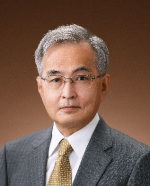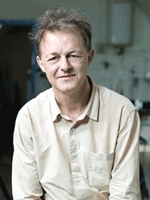Abstract
Onset of nucleate boiling (ONB) always needs wall superheating, dTsat, to activate bubble nucleation sites. In general, dTsat, ONB ranges from a few degrees to several tens of degrees depending on the type of fluids, wettability, surface structures and concentration of non-condensable gasses. From a viewpoint of electronic cooling, low dTsat, ONB is desirable to avoid thermal damages to electronic chips and to ensure stable boiling heat transfer. We have been studying the effects of wettability and solubility of air on the ONB and obtained some important findings for water. Regarding the wettability effect, hydrophobic area of the surface attracts dissolved air and works as an excellent nucleation site. Therefore, by making use of biphilic surfaces nucleate boiling is significantly enhanced. The boiling performance of biphilic surfaces is of about 7 times larger than that of mirror copper surface. This enhancement technique is very effective in subatmospheric conditions. Presence of both hydrophobicity and dissolved air drastically reduces the dTsat, ONB. In the case of subcooled boiling, the dTsat, ONB sometimes can become negative. We have unveiled the mechanism of early onset of nucleation by making use of a special experimental apparatus so to remove any initial dissolved air from the boiling water.
Challenges in lowering dTsat, ONB also concern other fluids. We succeeded to lower the dTsat, ONB for ethanol by halloysite nanotube (HNT) coating where ethanol displays contact angles higher than 90°. Nucleate boiling for ethanol is also enhanced on the biphilic surface by about 3 to 4 times when compared with bare copper surface. Our recent challenge is to lower the dTsat, ONB and enhance nucleate boiling for HFE7100 by making use of anodized aluminum surface, which has nanopores of 20-200 nm in size. The present talk will also report on some other experimental findings related to this recent study.
Biography
Professor Yasuyuki TAKATA is a Research Professor at International Institute for Carbon-Neutral Energy Research (I2CNER), Kyushu University. He is also Professor Emeritus at Kyushu University and Honorary Professor at the University of Edinburgh. He was a Professor in the Department of Mechanical Engineering, Kyushu University until March 2022. His research interests include two-phase flow and heat transfer, thermophysical properties of hydrogen at ultra-high pressure, micro refrigerator and micro heat transfer device and numerical simulation of thermal and fluid flow. He was the Presidents of Heat Transfer Society of Japan (HTSJ) from 2019 to 2020 and Japan Society of Thermophysical Properties in 2016. He served as the President of the Asian Union of Thermal Science and Engineering (AUTSE) from October 2020 to September 2022. He received numerous awards including the JSME Thermal Engineering Achievement Award in 2010, and ASME ICNMM2018 Outstanding Leadership Award in 2018 and Heat Transfer Society Award for Scientific Contribution in 2022. He is a Council Member of Science Council of Japan since October 2020.
Abstract
The high heat fluxes generated by modern electronic equipment necessitate a new approach to cooling these devices, as the dissipation of such high thermal loads using single-phase air or liquid heat sinks is no longer possible. The use of flow boiling in small to micro scale heat exchangers is consider as one of the most viable methods to help alleviate this thermal bottle neck – a few megawatts per meter square on average and reaching significantly higher values at the hot spots – allowing proper operation of these devices and new developments in the area. Other applications include possible use in small scale refrigeration systems, cooling of fuel cells, batteries and vehicle power electronics, solar photovoltaic panels and radar systems. The advantage of flow boiling in such systems is due to the possible small temperature difference of the substrate to be cooled reducing thermo-mechanical stresses and early failure plus small flow rates due to the high heat transfer coefficients resulting in smaller pumps and power consumption by the thermal management system. Fundamental issues that are currently being investigated in order to facilitate adoption of these small to micro scale evaporators include the definition of the macro to micro scale dimensions, the prevailing flow regimes and the effect of mass flux, heat flux, channel aspect ratio and length plus material and surface characteristics. These heat exchangers form part of a thermal system and the return temperature from the condenser and hence the possible degree of subcooling at the inlet of the evaporator is also a critical factor, bearing in mind the short lengths of the heat exchangers and the desire to achieve uniform substrate temperatures along the flow direction. The presentation will cover research in flow boiling in single tubes and channels and in multichannel heat exchangers with rectangular passages. Results for a microgap heat exchanger (single wide channel) of the same height and base area as the multi-channel heat exchangers will form benchmark comparative data. The effect of the parameters mentioned above plus the effect of coatings on the flow patterns, pressure drop and heat transfer rates will be presented. Flow instabilities will be discussed, along with ways to reduce their impact on the thermo-fluid characteristics of the evaporator. The development of correlations predicting the flow pattern boundaries, heat transfer rates and pressure drop will then be presented based on an analytical/statistical approach plus machine learning techniques. Finally, the integration of the micro evaporators in thermal management systems, which requires also the design of small-scale condensers will be discussed.
Biography
Professor Tassos Karayiannis studied at the City University London and the University of Western Ontario. He started his career as a researcher at Southampton University and later as a British Technology Group Researcher at City University. Subsequently he worked at London South Bank University and joined Brunel University London in 2005, where he is now Professor of Thermal Engineering Leader of the Two-Phase Flow and Heat Transfer Group and Director of the Energy Efficient and Sustainable Technologies Research Centre. Professor Karayiannis has carried out fundamental and applied research in a number of single-and two-phase heat transfer areas. Initially he worked on convective heat transfer and subsequently on the enhancement of pool boiling and condensation processes using high intensity electric fields. In parallel, he carried out extensive experimental work in pool boiling heat transfer with plane and enhanced surfaces. Professor Karayiannis has also been very actively involved with research in flow boiling in small to micro tubes and micro-multi-channels. This work involves fundamental studies as well as research leading to the design of high heat flux integrated thermal management systems. He has published more than 260 chapters in books, papers and industrial reports. He chairs the Committee of the International Conference Series on Micro and Nanoscale Flows now in its 8th edition. He is a Fellow of the EI and the IMechE, Member of the Assembly for International Heat Transfer Conferences and the Chairman of the UK National Heat Transfer Committee.
Abstract
Flow boiling is encountered in many industrial processes and the annular flow regime is of a great interest, due to its relatively high heat transfer coefficient (HTC). Flow boiling is however, characterized by a complex interplay of hydrodynamics, mass transfer, heat transfer and interfacial phenomena, which explains that most of the time HTC is predicted by correlations involving several dimensionless numbers. In annular flow, bubble nucleation at the wall can still be observed, disturbing the flow in the liquid film in the wall vicinity, impacting the wall shear stress. The liquid film is sheared by the vapor core at high velocity, inducing disturbance waves at its interface by Kelvin Helmholtz instabilities. The increase in the interfacial shear stress due the disturbance waves has a strong impact on the interfacial heat transfer.
To analyze the interplay between hydrodynamics and heat transfer in annular flow, we have performed dedicated experiments in a 6mm diameter tube with HFE-7000 as working fluid, in vertical upward and downward flows. The test section is a sapphire tube coated outside by a ITO deposit heated by Joule Effect. This transparent test section allows flow visualizations and characterization of disturbance waves at the surface of the liquid film. From pressure drop and void fraction measurements, liquid film thickness, wall and interfacial shear stress were measured. Heat transfer coefficient was determined by measurement of the wall temperature and heating power. The wall shear stress increased with the wall heat flux due to the bubble nucleation at the wall. Following a similar approach to Kim and Mudawar (2013) a correlation for the wall shear stress taking into account the forced convection and the bubble nucleation was derived and provided a good estimation of the experimental data. From image processing of the high-speed visualizations, velocities (Uw) and frequencies (Fw) of the disturbance waves in annular flow were measured. The interfacial shear stress was found to directly depend of the product Uw × Fw and a prediction of the interfacial friction factor was proposed in flow boiling for both upward and downward flows. The hydrodynamics of the turbulent liquid film was described by a eddy diffusivity model, using heat-flux-dependent wall shear stress correlations. The damping of the eddy diffusivity at the interface is based on the roll waves velocities characterized by image processing. Finally the profile of the eddy heat diffusivity was integrated across the liquid film to calculate the heat transfer coefficient. This theoretical modeling provides a good prediction of the heat transfer coefficient in both upward and downward flow and clearly points out the direct link between the hydrodynamics in the liquid film and the heat transfer coefficient in annular flow boiling.
Biography
Catherine Colin is Professor at the University of Toulouse and Researcher at the Institute of Fluid Mechanics in Toulouse (IMFT). She obtained her PhD in 1990 in Toulouse and joined IMFT as CNRS researcher. She became full Professor in 2002. Her main research topics are two-phase flow in normal and microgravity conditions, bubble dynamics, breakup and coalescence, turbulence modelling, pool and convective boiling. She is involved in several national and international networks and projects on two-phase flow for space applications and nuclear industry. She is authors of 150 publications in peer review journals or proceedings of international conferences and 15 keynotes lectures in international conferences. She was associated editor of Experimental Thermal and Fluid Science (2010-2018) and is associated editor of International Journal of Multiphase flows. She was involved the scientific committees or co-chair of several international conferences (International Conference on Multiphase Flow, International Conference on Boiling and Condensation heat transfer, Experimental Heat Transfer Fluid Flow and Thermodynamics). She was vice Chair in charge of research at the Polytechnic National Institute of Toulouse (2016-2020).
Abstract
Nucleate boiling is an exceptionally effective heat transfer process. However, a boiling crisis suddenly occurs when the heat flux to remove from a heated surface is too high. The maximum heat flux that can be sustained by nucleate boiling depends on surface properties and operating conditions, and it is an important operational limit in many scientific and industrial applications. Many scientists and engineers have attempted to describe this phenomenon and predict this limit mechanistically. However, a universal theory has eluded the thermal science community for almost a century.
Here, we reveal theoretically and experimentally the presence of a unifying law of the boiling crisis. This law emerges from an instability in the near-wall bubble interaction phenomenon, described as a percolation process driven by three fundamental boiling parameters: nucleation site density, average bubble radius and product of bubble growth time and detachment frequency. Our analysis demonstrates that the boiling crisis occurs on a well-defined critical boundary in the multidimensional space of these parameters for a wide variety of boiling surfaces and operating conditions. We anticipate that this fundamental property of the boiling process can inspire the design of engineered surfaces that enhance the nucleate boiling limit, as well as mechanistic modelling criteria for the design of advanced two-phase heat transfer system.
Biography
Dr. Matteo Bucci is Associate Professor of Nuclear Science and Engineering at MIT. He has joined the MIT faculty in 2016, where he teaches undergraduate and graduate courses in nuclear reactor engineering and design, and two-phase heat transfer. His thermal-hydraulics group at MIT focuses on two major research axes related to nuclear reactor safety and design: (1) New understanding of heat transfer mechanisms in nuclear reactors, (2) Engineered surfaces and coatings to enhance two-phase heat transfer. His group also develops and uses advanced diagnostics, such as high-speed infrared thermometry and phase-detection, and post-processing algorithms to perform unique heat transfer experiments. Matteo has published over 40 articles in the areas of two-phase flow and heat transfer, and surface engineering technology. For his research work and his teaching, he won several awards, among which the MIT Ruth and Joel Spira Award for Excellence in Teaching (2020), ANS/PAI Outstanding Faculty Award (2018), the UIT-Fluent Award (2006), the European Nuclear Education Network Award (2010), and the 2012 ANS Thermal-Hydraulics Division Best Paper Award (2012). In 2022, Matteo received the inaugural DOE Early Career Award for Nuclear Energy. Matteo is Editor of Applied Thermal Engineering and a consultant for the nuclear industry.
Abstract
Almost a century ago, dropwise condensation of steam on a hydrophobic surface was shown to have a 10X higher condensation heat transfer coefficient when compared to filmwise condensation on hydrophilic surface. The resulting overall heat transfer enhancement has the potential to result in a 2% overall energy efficiency increase for steam-based power plants, which are responsible for the overwhelming majority of global electricity production. The potential of dropwise condensation has driven researchers to design thin (≈100 nm-thick) hydrophobic coating materials. However, the lack of long-term (> 3 year) durability has been the main hindrance to coating utilization over the past century. In this talk, I will present our recent progress in designing thin and durable hydrophobic coating materials that enable stable dropwise condensation. First, I will discuss our fundamental studies probing the origin of hydrophobic coating degradation. We show that nanoscale pinhole defects in the coating are the source of steam penetration during condensation, where the condensate forms water blisters that pressurize and delaminate the coating. The understanding of the mechanics of water blister formation and growth enables us to develop quantitative guidelines for rational coating design and selection. Next, I will present the design of self-healing vitrimer thin film (dyn-PDMS) that actively eliminate coating defects to prevent the initiation of blisters. The dyn-PDMS thin film maintains excellent hydrophobicity after scratching, cutting, and indenting due to the dynamic exchange of its network strands. In addition to dyn-PDMS, I will show how alternate coating solutions such as fluorinated-diamond like carbon (F-DLC) with polymer-like low surface energy and metal-like exceptional mechanical properties can enhance dropwise condensation durability. We show experimentally that the high bending stiffness and coating adhesion makes F-DLC durable to 5,000 cycles of mechanical abrasion and enables more than 3 years of continual stable dropwise condensation. I end my talk by discussing our recent exciting demonstration of the stable dropwise condensation of two commercial low surface tension refrigerants (HFO-1336mzz(E) and HFO-1233zd(E)), which are novel, non-flammable, low global warming potential (GWP) Hydrofluoroolefins (HFO).
Biography
Professor Nenad Miljkovic is a Professor of Mechanical Science and Engineering at the University of Illinois at Urbana-Champaign (UIUC). He has courtesy appointments in Electrical and Computer Engineering, and the Materials Research Laboratory. He is the Co-Director of the Air Conditioning and Refrigeration Center (ACRC), which is supported by 25 industrial partners. His group’s research intersects the multidisciplinary fields of thermo-fluid science, interfacial phenomena, scalable nanomanufacturing, and renewable energy. He is a recipient of the NSF CAREER Award, the ACS PRF DNI Award, the ONR YIP Award, the ASME ICNMM Young Faculty Award, the ASME Pi Tau Sigma Gold Medal, the CERL R&D Technical Achievement Award, the US Army Corps of Engineers ERDC R&D Achievement Award, the SME Young Faculty Award, the Bergles-Rohsenow Young Investigator Award in Heat Transfer, the ASME EPPD Early Career Award, and is an ASME Fellow.
Abstract
Dew forms when a cold material is placed in a humid atmosphere. We discuss how a few textured, hydrophobic materials can self-evacuate the dew forming at their surface. We focus in particular on the case of materials decorated with conical nanostructures, for which it is found that water droplets can remain quasi-spherical down to micrometric diameters – leading to remarkable anti-dew properties.
Biography
David Quéré is a Senior Researcher at CNRS and ESPCI-Paris and a Professor at École Polytechnique. He is engaged in experimental research in Soft Matter Physics and Fluid Mechanics, with a strong interest in interfacial hydrodynamics (drops, films, bubbles, coating, wicking) as well as in aerodynamics, morphogenesis and biomimetics. He is on the Editorial Board of Physical Review Fluids, Soft Matter, Advances in Colloid & Interface Science and Droplet. He received the 2014 Silver Medal of CNRS and the 2021 Fluid Dynamics Prize of APS, and he became a Distinguished Professor at ESPCI in 2016.








